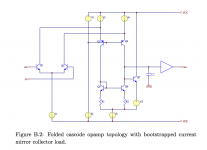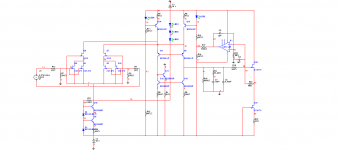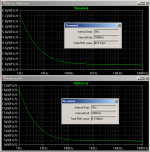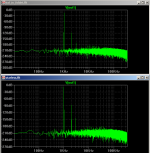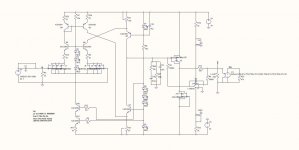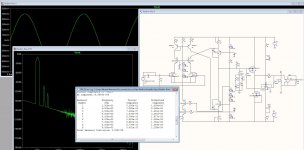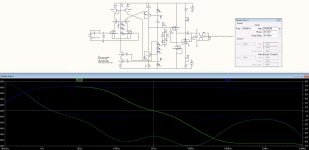Yes, this ones are pretty cool to cascode low Ugs N channel J-Fets:
PN4391 Datasheet pdf - Leaded JFET General Purpose - Central Semiconductor
PN4391 Datasheet pdf - Leaded JFET General Purpose - Central Semiconductor
Something like that works very nice ( AD797, LT1468 ) and gives very low distortion and high bandwidth.
Of cause you have a Fet input.
Yep, classics. Even without bootstrapping it's already very good, and I'm not fancying 0.000.... thd games. Something like this (attached) should do it. Servoing ccs IME has always worked better then injection to gain nodes. What I still don't like is that non inverting servo and current through mirrors could be higher, but upper left bjt is already at 300mW dissipation. I've done some noise and thd sims vs. original starless as now I take it as benchmark point (because I like it so much). Other parameters should be on pair.
What do you think Joachim ? Should I give it a try or something needs further improvement ?
I'm still playing with this circuit only to try balanced in, that's something I haven't tried yet. I don't expect much, but want to try it for myself.
I didn't had a chance to listen to SE version, still have to build second channel, maybe this weekend.
Attachments
Another way of folding the cascode....
And looks even simpler. Have you actually build it ?
Sampler and MiiB, i like both of your solutions but have only experience with the AD797 style so i can not say if Michaels cross folding sounds better. MiiB, maybe you or someone else should build it. Concerning balanced if have experience with the FPS ( Linear Audio 0 ) and the Suesskind Rauschfrei. In both cases i can drive balanced and unbalanced. Balanced sounds better. It gives better resolution and micro detail. There is also an effect as if the sound is "expanded". It sounds more spacious and dynamic. It is too early to say that in general balanced sounds better but it is the case with the mentioned circuits. Sampler, i already told you the paralleling trick when you think dissipation is too high. Two BJTs in parallel hive a transistor with the same Hfe then one but with double the dissipation. I do that in the Opus magnum out of the reason that low power transistors worked much better then TO220 parts in that particular application. You could also modify your servo as two inverted Opamps in series. The first with Pin 3 grounded and 1Mohm in series with Pin 2. Then 1uF from Pin 2 to Pin 6 and then a second Opamp with 10K and 10k resistors setup as a unity gain inverting buffer.
Sampler, yes, a "bias servo" as i call it is preferable because it is not in the direct signal path. On the other hand i have build servo circuits that are in the feedback path that sounded very good. I usually use the OPA134. It has some treble distortion especially when loaded with less then 2kHz but the servo does not contribute much over 1kHz so it is safe to use it. Usually i use inverted servos but i also build circuits with non inverted servos that sounded good. When i read of how much the servo or type of Opamp in the servo effects sound i think it is over rated or incompetently inplemented.
Concerning the balance in an AD797 style current mirror i know that very little unbalance effects the circuit much.
Concerning the balance in an AD797 style current mirror i know that very little unbalance effects the circuit much.
Here you find a lot of information about low noise cascodes :
hosticka jssc dec - Google Search
Willy Sansen is a kind of analog prophet. You find the cross coupling here and also something i have never seen before ( until i read his book ), the regulated or gain boosted cascode ( page 34 and following ).
hosticka jssc dec - Google Search
Willy Sansen is a kind of analog prophet. You find the cross coupling here and also something i have never seen before ( until i read his book ), the regulated or gain boosted cascode ( page 34 and following ).
Thank you for your comments Joachim. Yes, right you are about R6 R8. I know imbalance would be real issue, as output impendance is really high, so servo goes here by default. About servos, if I may.... I think I have "know how" to make them almost invisible, but that is with amps. When operating in dB it's really simple to forget that here we are dealing with circuits that actually amplifies signal 5000 times or more, and ac currents involved are microscopic all aver the circuit. So it has to be as ideal as it gets. What I have found till now playing with servoing starless is that it has influence, no matter what efforts are taken. It's just that there is almost no node in a whole circuit that would be enough far away from audio path, as I fail to provide more scientific explanation. The best position was lower "lazy" current mirror emmiter resistor. Contribution was really small and ONLY in lower freq. more exactly bass has became "tight" and I really like it soft and spacious. For the record - frq. response was exactly the same as without servo, AD711 in so8 with ground plane, excellent local decoupling, good pps cap etc. For caparison, servoing "active" upper current mirror was a mess on whole audio range, I try to explain it by some servo feed through in uV range that is phase shifted in respect to emmiter voltage. Your "strange" servo was really better, but again, subtle changes to overall sound. On all occasions there was same coupling cap to buffer present, to make it more apples to apples. Taking it out, always lead to more micro details, as expected. So it's all about choosing best compromise.
Yes, thats right. We have to do with very low levels of voltage and current plus huge amplification so servoing that is tricky. I agree, a cap in the signal path is always audible.
It takes away that see through feeling to a certain degree. Still i think one cap or the other is ok for safety reasons, simplicity, un symmetric bias that can lower distortion etc.
They can even be used for tuning the sound. A Mundorf ZN tin foil gives a kind of very attractive warmth and an Evox-Rifa PHE450 adds some speed and brilliance. You will find a solution still i can feel the pain in you. That in known as "designers pain" and has to do with the incredible amount of choices you have to make and the unavoidable compromises by still trying to advance the art. That is also the reason i can not simple recommend a certain "best" circuit for the newbe.
It takes away that see through feeling to a certain degree. Still i think one cap or the other is ok for safety reasons, simplicity, un symmetric bias that can lower distortion etc.
They can even be used for tuning the sound. A Mundorf ZN tin foil gives a kind of very attractive warmth and an Evox-Rifa PHE450 adds some speed and brilliance. You will find a solution still i can feel the pain in you. That in known as "designers pain" and has to do with the incredible amount of choices you have to make and the unavoidable compromises by still trying to advance the art. That is also the reason i can not simple recommend a certain "best" circuit for the newbe.
Last edited:
Thanks for the link to Willy Sansen papers, he is a guru. Lots of good stuff that I to didn't know or forgot over years. Reading slides with minimum comments, makes me feel young again and preparing for tu exams 
Yes, that was for me a common practice for years, but boy o boy I'm tired of listening to caps, so now if I can go dc coupled, I do.
I think there is no "best circuit", it's always just a set of best possible compromises, that aether works for ones taste or not. I personally am a big fan SE minimalistic no or minimum nfb type circuits, be it tubes or discrete, as it's always quite easy to make them sound right (not that "right" is 2% second harmonic sweetness), and they don't need tremendous engineering rnd, tuning, countless measurements etc. But with low mc phono stage I feel like there is no "zen" approach, at least without transformers involved, and real engineering must be utilized to make a good sounding stage. Of course when things comes to recommendation or preferences it's as subjective as it gets.
Yes, that was for me a common practice for years, but boy o boy I'm tired of listening to caps, so now if I can go dc coupled, I do.
I think there is no "best circuit", it's always just a set of best possible compromises, that aether works for ones taste or not. I personally am a big fan SE minimalistic no or minimum nfb type circuits, be it tubes or discrete, as it's always quite easy to make them sound right (not that "right" is 2% second harmonic sweetness), and they don't need tremendous engineering rnd, tuning, countless measurements etc. But with low mc phono stage I feel like there is no "zen" approach, at least without transformers involved, and real engineering must be utilized to make a good sounding stage. Of course when things comes to recommendation or preferences it's as subjective as it gets.
I would love to build it, but for the moment I have more than enough on my table, with speaker upgrades.... You know that is what pay the bills. But in due time i just, until then i would be nice if somebody took the time....I do think there is some novelty in this way of folding...and for sure the distortion levels and spectra looks extremely good...
Frequency showed with the 4.pole engaged...
Frequency showed with the 4.pole engaged...
Attachments
Last edited:
